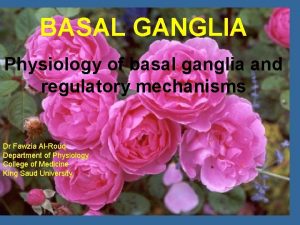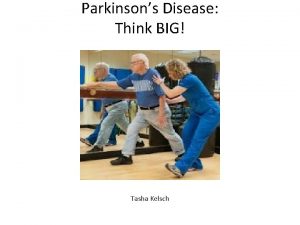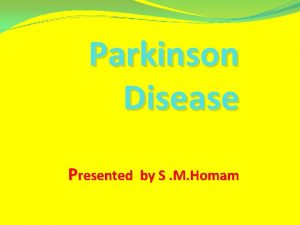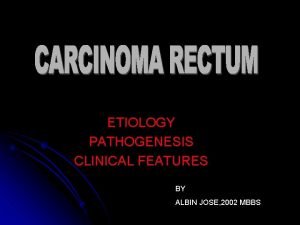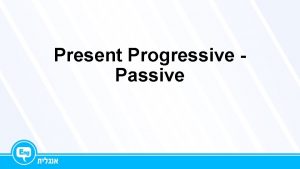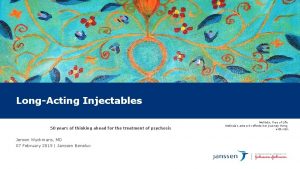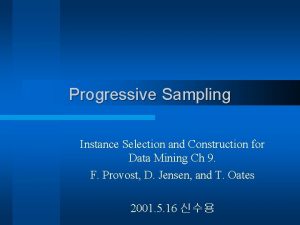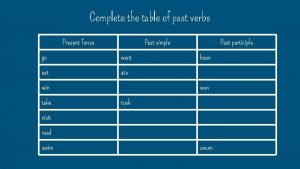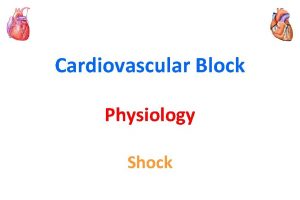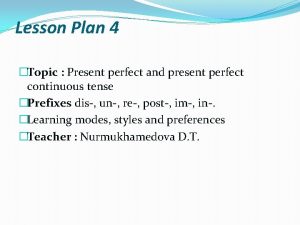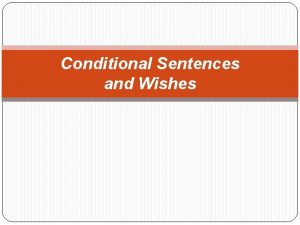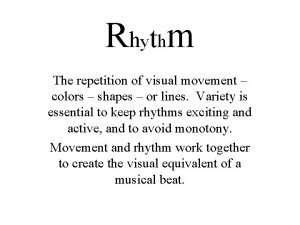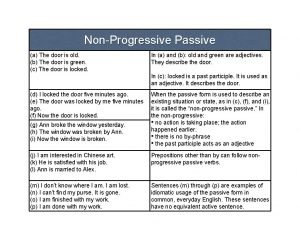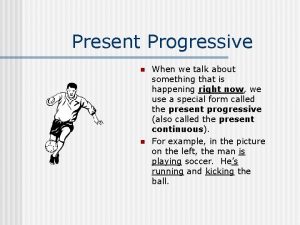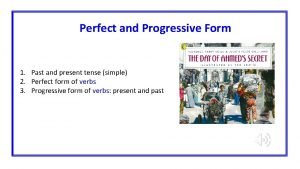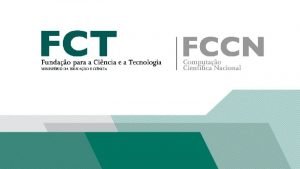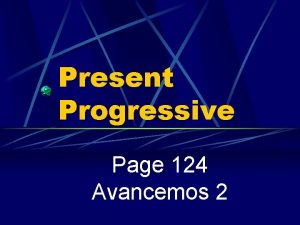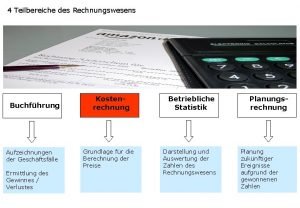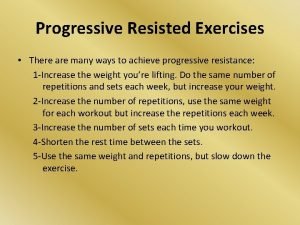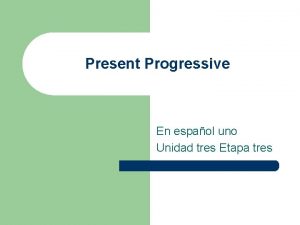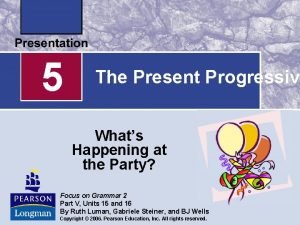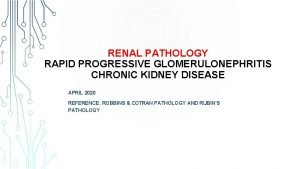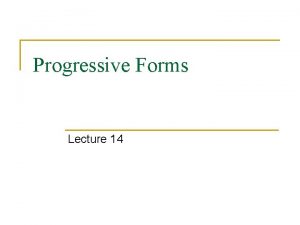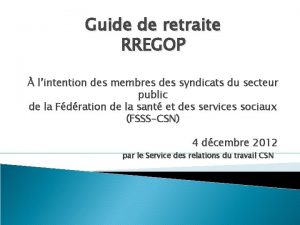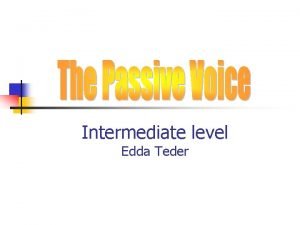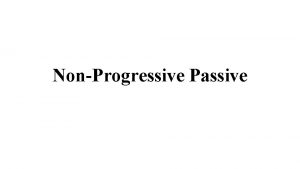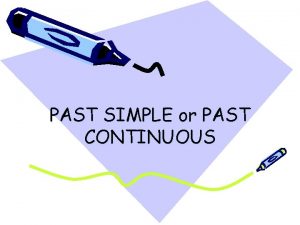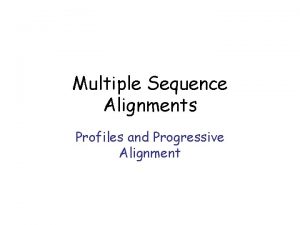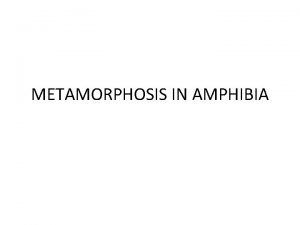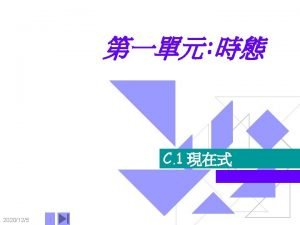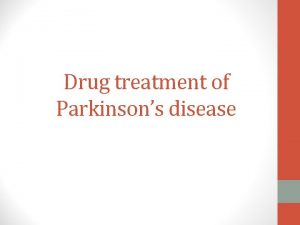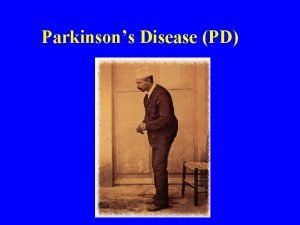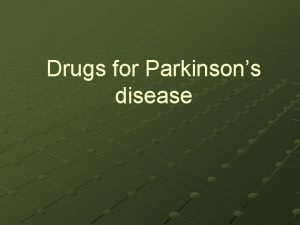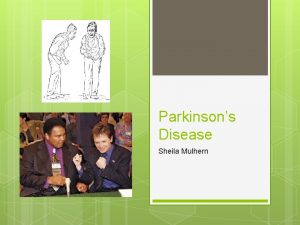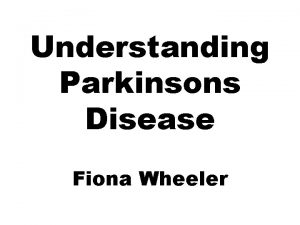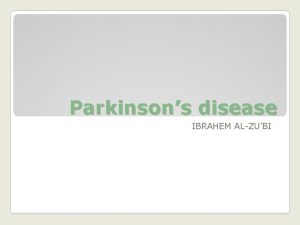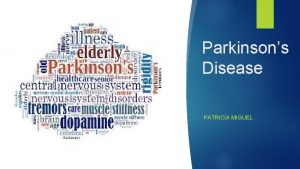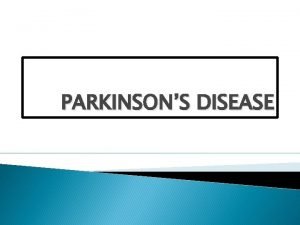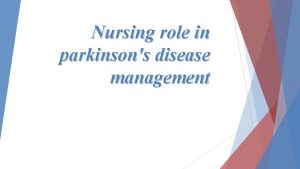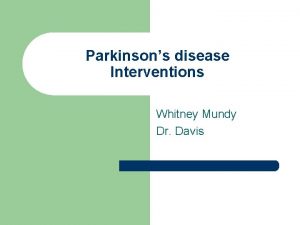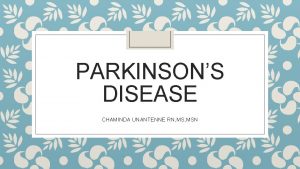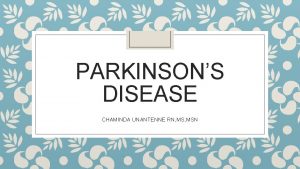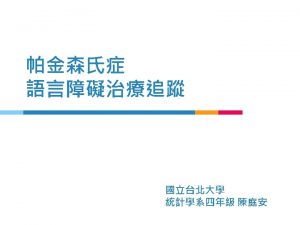Parkinsons Disease Parkinsons disease PD is a progressive

































































































- Slides: 97

Parkinson’s Disease

� Parkinson’s disease (PD) is a progressive disorder of the central nervous system (CNS) with both motor and nonmotor symptoms. � Motor symptoms include the cardinal features of rigidity, bradykinesia, tremor, and, in later stages, postural instability. � Nonmotor symptoms may precede the onset of motor symptoms by years. � Early symptoms can include loss of sense of smell, constipation, rapid eye movement (REM) sleep behavior disorder, mood disorders, and orthostatic hypotension. � Other nonmotor symptoms include altered bladder function, excessive saliva, integumentary changes, difficulty speaking and swallowing, and cognitive problems (slowed thinking, confusion, and in some cases dementia). � Onset is insidious with a slow rate of progression. � Disruptions in daily functions, roles, and activities, as well as depression, are common in individuals with PD.

INCIDENCE � PD is a common disease that affects an estimated 7 to 10 million people worldwide. � More than 2% of people older than 65 years of age have PD, second only to Alzheimer’s disease among neurodegenerative disorders. � The prevalence of the disease is expected to increase substantially in the coming years due to the aging of the population. � The average of onset is 50 to 60 years. � Only 4% to 10% of patients are diagnosed with early-onset PD (less than 40 years of age). � Young-onset PD is classified as beginning between 21 and 40 years of age � Juvenile-onset PD affects individuals less than 21 years of age. � Men are affected 1. 2 to 1. 5 times more frequently than women

ETIOLOGY �The term parkinsonism is a generic term used to describe a group of disorders with primary disturbances in the dopamine systems of basal ganglia (BG). �Both genetic and environmental influences have been identified. Parkinson’s disease, or idiopathic parkinsonism, is the most common form, affecting approximately 78% of patients. �Secondary parkinsonism results from a number of different identifiable causes, including viruses, toxins, drugs, tumors, and so Forth. �The term parkinsonism-plus syndromes refers to those conditions that mimic PD in some respects, but the symptoms are caused by other neurodegenerative disorders.


Parkinson’s Disease �Parkinson’s disease was first described as “the shaking palsy” by James Parkinson in 18174 and refers to those cases where the etiology is idiopathic (unknown) or genetically determined. � Two distinct clinical subgroups have been identified. � Postural instability and gait disturbances (postural instability gait disturbed [PIGD]). � Another group includes individuals with tremor as the main feature (tremor predominant). � Genetic forms of PD represent less than 10% of cases overall. � Gene mutations; PARK 1, PINK 1, LRRK 2, DJ-1, and glucocerebrosidase, among others). � Genes categories: � causal genes; produce the disease � associated genes; increase the risk of developing it.

Secondary Parkinsonism; Postencephalitic Parkinsonism �The influenza epidemics of encephalitis lethargica that occurred from 1917 to 1926 affected large numbers of individuals. � The onset of parkinsonian symptoms typically occurred after many years, giving rise to theory that a slow virus infected the brain. �In the absence of a recent outbreak, this type of parkinsonism is no longer seen. �Moving case histories are portrayed in the book Awakenings by Oliver Sacks.

Secondary Parkinsonism; Toxic Parkinsonism �Parkinsonian symptoms occur in individuals exposed to certain environmental toxins, including pesticides (e. g. , permethrin, beta-HCH, paraquat, maneb, Agent Orange) and industrial chemicals (e. g. , manganese, carbon disulfide, carbon monoxide, cyanide, methanol). �The most common of these toxins is manganese, which represents a serious occupational hazard to many miners from prolonged exposure. �Severe and permanent parkinsonism has been inadvertently produced in individuals who injected a synthetic heroin containing the chemical MPTP (1 -methyl-4 -phenyl-1, 2, 3, 6 tetra/ hydropyridine). �It is important to note that simple exposure is never enough to cause the disease.

Secondary Parkinsonism; Drug. Induced Parkinsonism (DIP) � A variety of drugs can produce extrapyramidal dysfunction that mimics the signs of PD. hese drugs are thought to interfere with dopaminergic mechanisms either presynaptically or postsynaptically. � They include: 1. neuroleptic drugs such as chlorpromazine (horazine), haloperidol (Haldol) thioridazine (Mellaril), and thiothixene (Navane); 2. antidepressant drugs such as amitriptyline (Triavil), amoxapine (Asendin), and trazodone (Desyrel); and 3. antihypertensive drugs such as methyldopa (Aldomet) and reserpine. � High doses of these medications are particularly problematic in the elderly. Withdrawal of these agents usually reverses the symptoms within a few weeks, although in some cases the effects can persist and may be related to subclinical PD. � Parkinsonism can be caused in rare cases by metabolic conditions, including disorders of calcium metabolism that result in BG calcification. hese include hypothyroidism, hyperparathyroidism, hypoparathyroidism, and Wilson’s disease.

Parkinson-Plus Syndromes � A group of neurodegenerative diseases can affect the substantia nigra and produce parkinsonian symptoms along with other neurological signs. � These diseases include striatonigral degeneration (SND), Shy-Drager syndrome, progressive supranuclear palsy (PSPO), olivopontocerebellar atrophy (OPCA), and cortical– basal ganglionic degeneration (CBGD). � In addition, parkinsonian symptoms can be exhibited in patients with multiinfarct vascular disease, Alzheimer’s disease, diffuse Lewy body disease (DLBD), normal pressure hydrocephalus (NPH), Creutzfeldt-Jakob disease (CJD), Wilson’s disease (WD), and juvenile Huntington’s disease. � Many of these conditions are rare and affect relatively small numbers of individuals. � Early in their course, these diseases may present with rigidity and bradykinesia indistinguishable from PD. � However, other diagnostic symptoms eventually appear (e. g. , cognitive impairment in Alzheimer’s disease). � Another diagnostic feature is that Parkinson-plus syndromes typically do not show measurable improvement from the administration of anti-Parkinson medications such as levodopa (L-dopa) therapy (termed the apomorphine test).

PATHOPHYSIOLOGY � The BG is a network of subcortical nuclei consisting of the caudate nucleus, the putamen, the globus pallidus, and the subthalamic nucleus along with the substantia nigra. The caudate and the putamen together are called the striatum (Fig. 18. 1). � The BG engages in a number of parallel circuits or loops, only a few of which are motor. � The direct motor loop through the BG consists of signals transmitted from the cortex to putamen to globus pallidus, to ventrolateral (VL) nucleus of the thalamus, and back to cortex (supplementary motor area [SMA]) (Fig. 18. 2). This VL-SMA connection is excitatory and facilitates discharge of cells in the SMA. he BG thus serves to activate the cortex via a positive-feedback loop and assists in the initiation of voluntary movement. Inhibition of the thalamus by the BG is thought to underlie the hypokinesia seen in PD. � An indirect loop through the BG involves the subthalamic nucleus, the globus pallidus interna, and substantia nigra pars reticulata to the superior colliculus and midbrain tegmentum (Fig. 18. 3). � This indirect loop serves to decrease thalamocortical activation. � The BG projection to the superior colliculus assists in regulation of saccadic eye movements. � The BG projection to the reticular formation assists in the regulation of trunk and limb musculature (via extrapyramidal pathways) sleep and wakefulness, and arousal. Other circuits in the BG are involved with memory an cognitive functions.

Definition �Parkinson’s disease is defined by (1) degeneration of dopaminergic neurons in the BG in the pars compactus of the substantia nigra that produce dopamine and (2) as the disease progresses and neurons degenerate, the presence of cytoplasmic inclusion bodies, called Lewy bodies. �Substantial neurodegeneration occurs in PD before the onset of motor symptoms with clinical signs emerging at 30% to 60% degeneration of neurons. �Loss of the melanin-containing neurons produces characteristic changes in depigmentation in the substantia nigra with a characteristic pallor




STAGES OF PARKINSON’S DISEASE �Postmortem studies by Braak and colleagues have yielded evidence supporting the view that PD is a widely dispersed neurodegenerative disease that demonstrates a progression through different stages. �Early on (stage 1) lesions are found in the medulla oblongata (dorsal IX/X nucleus or intermediate reticular zone).

�In stage 2, pathology is expanded to involve lesions of the caudal raphe nuclei, the gigantocellular reticular nucleus, and coeruleus-subcoeruleus complex. �In stage 3, involvement of the nigrostriatal system is apparent (pars compacta of the substantia nigra). �In stage 4, lesions are also found in the cortex (temporal mesocortex and allocortex). �In stage 5, pathology is extended to involve the sensory association areas of the neocortex and prefrontal neocortex. �In stage 6, pathology is extended to involve the sensory association areas of the neocortex and premotor areas.


MEDICAL DIAGNOSIS � Diagnosis at onset of PD is difficult with accurate diagnosis possible only with continued observation of evolving clinical signs and symptoms. � There is no single definitive test or group of tests used to diagnose the disease. � The diagnosis is made on the basis of history and clinical examination. � Handwriting samples, speech analysis, interview questions that focus on developing symptoms, and physical examination are used. � In the preclinical stage, nonmotor symptoms predominate. � There is an increasing focus on use of questionnaires and tests (e. g. , olfactory testing, imaging of cardiac sympathetic innervation) that focus on emerging nonmotor symptoms. � Often symptoms of loss of smell, sleep disturbances, vivid dreams with REM alterations, foot dystonia and foot cramping similar to restless legs syndrome, orthostatic hypotension, and constipation are symptoms that are present many years before an official diagnoses of PD is made.

�A diagnosis of PD is typically made if at least two of the four cardinal motor features are present. �Exclusion of Parkinson-plus syndromes is necessary. �The presence of extrapyramidal signs that are bilaterally symmetrical and do not respond to L-dopa and dopamine agonists (apomorphine test) is suggestive of these syndromes, not PD. �Imaging can be used to rule out other pathologies. �In vivo functional imaging (magnetic resonance imaging [MRI]) using chemical markers to identify dopaminergic deficits in PD and related disorders identifies dopamine deficiency but does not discriminate between PD and other causes of parkinsonism.

CLINICAL COURSE � The disease is progressive, with a long subclinical period (without apparent clinical manifestations) estimated to be at least 5 years. � Mean PD duration is approximately 13 years. � There is variability of the rate of progression. � Patients with a young age at onset or who are tremor predominant typically demonstrate a more benign progression. � Patients with PD who present with postural instability and gait disturbances (the PIGD group) tend to have more pronounced deterioration with a more rapid disease progression. � Neurobehavioral disturbances and dementia are also more common in this group. With L-dopa therapy, progression is generally slower with an overall improvement in mortality rates. � The most common causes of death are cardiovascular disease and pneumonia

Hoehn-Yahr Classification of Disability Scale �An estimate of the stage and severity of the disease can be made using a staging scale. �The most widely used in clinical practice and research trials is the Hoehn-Yahr Classification of Disability Scale �It provides a broad measure for charting the progression of the disease using motor signs and elements of functional status. �Stage I is used to indicate minimal disease involvement, whereas stage V is indicative of severe deterioration in which the patient is confined to bed or a wheelchair.


MEDICAL MANAGEMENT �Medical management is directed at slowing disease progression using neuroprotective strategies, and symptomatic treatment of motor and nonmotor symptoms. �Management becomes increasingly more challenging over time for patients with moderate and advanced disease (i. e. , Stage III or higher on the Hoehn-Yahr Classification of Disability Scale).


Nutritional Management � A high-protein diet can block the effectiveness of L-dopa. � The dietary amino acids in protein compete with L-dopa absorption. � This is particularly problematic in patients with chronic disease who exhibit fluctuations in motor performance. � Thus, patients are generally advised to follow a high-calorie, lowprotein diet. � Generally no more than 15% of calories should come from protein. � Dietary recommendations may also include shifting the intake of daily protein to the evening meal when patients are less active. � These modifications minimize motor fluctuations and maximize responsiveness to L-dopa therapy. � The patient is encouraged to eat a variety of foods and may be advised to take dietary supplements to ensure adequate intake of vitamins and minerals.

� Patients are also advised to increase their daily intake of water and dietary fiber to help control problems of constipation. � Rigidity and bradykinesia can limit upright posture and UE feeding movements. Learned motor plans, for example, using a cup or eating utensils, may also be difficult. � Occupational therapy intervention to improve feeding and recommend adaptive eating devices is of considerable importance in helping to maintain nutrition and general health status. � The speech-language pathologist also has an important role in the evaluation of dysphagia and the recommendation of strategies to assist with swallowing dysfunction. � Patient, family, and caregiver education should focus on the importance of maintaining good nutritional intake. � Percutaneous endoscopic gastrostomy (PEG) is reserved for advanced disease when all other strategies for dysphagia fail.

Deep Brain Stimulation �Deep brain stimulation (DBS) involves the implantation of electrodes into the brain where they block nerve signals that cause symptoms. �Brain electrodes are placed in the subthalamic nucleus (STN) or less frequently the globus pallidus (GPi). �An impulse generator (IPG), similar to a pacemaker, is implanted in the subclavicular area and a thin wire goes under the skin to connect to the brain electrodes. Highfrequency stimulation is provided. �The patient can control the pacemaker’s “on–off” switch using a controller while the physician determines the amount of stimulation it delivers, tailoring it to the individual’s needs.

� DBS is effective for the treatment of advanced PD. � Improvement of tremor that is refractory to pharmacological therapy is seen in approximately 90% of patients with one-third to one-half of patients experiencing total suppression with DBS of the STN. � DBS has been shown to successfully control PD symptoms of motor overactivity (dyskinesias), substantially increase “on” time, and improve ADL scores. � DBS has also been shown to reduce the medication requirements and is a treatment of choice in patients with medication-resistant motor fluctuations and dyskinesia. � Other motor symptoms of akinesia, rigidity, weakness, and reduced walking speed may improve with DBS though the responses are more variable. � Possible adverse effects include confusion, headache, speech problems, gait disturbances, and falling. � Most of the complications are temporary and resolve within 6 months. � Surgical risks (intracerebral hemorrhage, infection) and mechanical problems with the device (lead breakage, generator malfunction) are also possible. � Deep brain stimulation has largely replaced stereotaxic surgical procedures of the brain (thalamotomy and pallidotomy)

FRAMEWORK FOR REHABILITATION �Rehabilitation has an important role in reducing activity limitations while promoting activity participation and independence. �In addition, known complications of PD can be reduced or prevented while quality of life is promoted. �Optimal management involves a coordinated interdisciplinary team to oversee a comprehensive plan of care to address the patient’s individual clinical problems, concerns, and needs.

� The team typically includes the physician, nurse, physical therapist, occupational therapist, speech-language pathologist, and social worker. � Referral to other specialists may also be necessary, for example, psychologist, nutritionist, gastroenterologist, urologist, pulmonologist, and so forth. � As with any team, the patient is the central figure with family and caregivers being key members. � The ideal rehabilitation program considers the patient’s disease history, course, and symptoms, together with impairments, activity limitations, and participation restrictions. � Of equal importance are the patient’s abilities (assets), priorities, and resources, including family, home, and community resources. � Deterioration of condition and medication-induced fluctuations in performance should be expected. � Depression and anxiety are common and should be carefully monitored. � The overall focus is on long-range planning, with anticipated episodes of care including hospital-based, outpatient, and home/community-based care.

Therapeutic Care Continuum �A therapeutic care continuum based on disease stage (early, middle, late) is an effective way to organize care. �Interventions are restorative (aimed at improving impairments, activity limitations, and participation restrictions), preventative (aimed at minimizing potential complications and indirect impairments), and compensatory (aimed at modifying the task, activity, or environment to improve function) �It is critical for the whole team to provide a supportive environment to assist patients and their family members in the difficult adjustment to living with a chronic and progressive disease. �In the early stage of the disease, patients are functional and independent with minimal impairments.

� A referral for physical therapy is often delayed at this stage, although benefits could clearly be obtained in improving fitness levels and delaying or preventing indirect impairments. Patients are typically seen on an outpatient basis. � During the middle stage of the disease, symptoms are more readily apparent and activity limitations emerge. � The patient may still be independent in gait and ADL, although performance is slowed and less efficient. Some assistance may be required. � The patient may be seen as an outpatient, during home care, or during a brief inpatient admission. There are numerous benefits to rehabilitation services. � Exercise training programs have been shown to be effective for patients with mild to moderate � PD in improving motor performance. � Perceived quality of life and subjective well-being are also improved. � Family and caregiver instruction is intensified to assist the patient in remaining as functionally independent as possible

�In the late stage, disease progression leads to increased and more severe impairments and complications. �Patients are dependent in many or most of their daily functional mobility skills and ADL and are typically wheelchair bound or bedridden. �Family and community resources are vital in maintaining the patient in the home. �Some patients may require placement in a chronic care facility. �These changes can be a source of great anxiety and frustration to the patient and family. �Goals need to be restructured. �The therapist needs to focus on preventative care to avoid secondary complications that may be life threatening (e. g. , pneumonia, pressure ulcers, and so forth).

�Compensatory training focuses on maintaining function, including being upright and out of bed as much as possible. �Safety for both the caregiver and the patient becomes a primary concern as maximal assist dependent transfers become the norm. �Often, environmental adaptations may mean the difference between total dependence and modified dependence. �The rehabilitation team should be supportive of the patient’s efforts no matter how small they may be. �Patients in late-stage PD demonstrate extremely limited skills to interact with their environment, with increasing social isolation and withdrawal.

�Families also suffer from the increasing demands of care, burnout, and social isolation. herapists need to maximize psychosocial support and be readily available for consultation. �The preferred practice pattern for patients with PD from the Guide to Physical herapist Practice is 5 E, Impaired Motor Function and Sensory Integrity Associated with Progressive Disorders of the Central Nervous System— Acquired in Adolescence or Adulthood. �In this document the reader will find relevant information on patient/client diagnostic classification; ICD-9 -CM codes; examination components; considerations for evaluation, diagnosis, and prognosis; and suggested interventions. �Thus, the Guide to Physical therapist Practice serves as a primary resource in designing an appropriate plan of care (POC) and documenting the services provided and outcomes achieved.

PHYSICAL THERAPY EXAMINATION AND EVALUATION � A comprehensive examination is required to determine the level of impairments and degree of function. � Subsequent reexamination at specified intervals is used to distinguish change in status as well as effects of treatment. � Data are obtained from the history, systems review, and relevant tests and measures (Box 18. 3). � The selection of examination procedures and instruments is determined by the patient’s unique status. � The severity of problems, stage of disease, age, phase and setting of rehabilitation, and other factors must all be taken into account in structuring the examination and evaluating data. � During the early and middle stages of PD, measures of impairment and physical performance are relatively stable. � During late stages of the disease and under conditions of fluctuating symptoms with pharmacological instability, measures can be expected to be less stable.





PHYSICAL THERAPY INTERVENTION � A combined approach of physical therapy and pharmacological intervention plays a key role in the management of the patient with PD. Despite best efforts, progressive disability develops and affects the patient’s quality of life. � A variety of interventions to maximize functional ability and minimize secondary complications are used to achieve goals and outcomes, including direct interventions, supervision of assistive personnel, patient/family/caregiver instruction, environmental modification, and supportive counseling. � Early intervention is critical in preventing the devastating musculoskeletal impairments these patients are so prone to develop. Interventions also focus on improvement of motor function, exercise capacity, functional performance, and activity participation. � Education and support of patients, family members, and caregivers at each stage of the disease is critical to attaining optimal outcomes. � The research team for the Cochrane Database of Systematic Reviews found that there was insufficient evidence to support or refute the efficacy of any given form of physical therapy over another in PD. � The researchers stressed the need for improved research in this area, including large well-designed placebo-controlled randomized controlled trials (RCTs) to demonstrate the efficacy and effectiveness of “best practice” physical therapy in PD.

Motor Learning Strategies �Patients with PD typically demonstrate motor learning deficits, including slower learning rates reduced efficiency, and increased context-specificity of learning. �Learning complex movement sequences and movements dependent on internally generated cues are more difficult than those dependent on external cues. �In the early and middle stages of the disease, patients can improve their performance through practice and by using additional sensory information. �The amount and persistence of learning are variable and can be expected to be lower than in healthy age-matched people. �In more advanced stages and in the presence of pronounced cognitive deficits, training will likely be less successful. 163 -165 he therapist needs to structure treatment sessions to optimize motor learning.

� Critical elements of practice include a large number of repetitions to develop procedural skills. he therapist should instruct the patient to deliberately focus his or her full attention on the desired movement. � The environment should also be modified to reduce clutter and competing attentional demands that may trigger freezing episodes. � The task should be modified to minimize competing cognitive demands (e. g. , dual tasking). � Long and complex movement sequences should be avoided or broken down into component parts. � Initially, random practice order (i. e. , practice in which the patient switches back and forth between tasks) should be avoided in favor of a blocked practice order, thereby reducing the effects of contextual interference. � Use of structured instructional sets has been shown to improve movement speed and consistency. � For example, walking patterns can be improved with focused instructions of “swing your arms, ” “walk fast, ” or “take large steps. ” � For the patient with advanced disease and cognitive deficits, repetitive drilllike practice should be used together with an increased focus on caregiver training to ensure safety.

� External cues have been shown to be effective in triggering sequential movements and improving movement characteristics in individuals with mild to moderate PD. � Visual cues include stationary floor markings (e. g. , brightly colored lines on the floor placed perpendicular to the gait path and spaced about one step length apart) and dynamic transportable cues (e. g. , laser light signals). � A laser light that projects a line onto the floor in front of the patient can be mounted on an assistive device (cane or walker) or on a subject’s chest harness. � Visual cues have been shown to improve stride length and velocity while cadence was relatively unchanged. � Freezing episodes are also reduced. � Rhythmic auditory stimulation (RAS) includes use of a metronome beat or a steady beat from a musical listening device. � RAS has been shown to improve gait speed, cadence, and stride length. � The beat is typically set 25% faster than the patient’s preferred pace.

� � � Auditory cues such as “Big step” have also been shown to improve gait. Examples include “ 1, 2, 3 stand, ready set go, big first step. ” Cues should be consistent, not rushed and have a rhythmical quality to them. Auditory cues appear to have a greater influence on the temporal components of movement (e. g. , gait cadence, stride synchronization) rather than on spatial components. Multisensory cueing (use of both visual and auditory cueing) has been used for patients with PD. When sensory enhanced therapy using multisensory cueing was compared with conventional therapy, significant improvements were found in the sensory training group. External cues appear to facilitate movement by utilizing different brain areas. For example, the premotor cortex is active in the generation of movement in response to visual or auditory stimuli. Normally the supplementary motor area (SMA) with inputs from the BG is involved in the initiation of self-generated movements and the performance of well-learned, repetitive movement sequences. External cues heighten patient attention through a common mode of action, that is, to bypass the diminished internal cueing of the BG. Thus, focus is shifted to less automatic movement using alternative, more conscious motor control pathways. This is supported by the finding that when patients were requested to carry out a secondary task while walking (dual-tasking), the beneficial effects of visual and attentional cues was reduced.

� Selection of the type of cue and successful use will depend on the individual patient with predicted long-term benefit of a particular type of cue linked to its initial success. � External cues are clearly not effective for all patients with PD. � For patients with advanced disease and severe reductions in stride length, cueing is not effective. � When cueing is withheld, performance can be expected to deteriorate. � Focused attention with cueing requires constant vigilance and is cognitively demanding. � Thus, cueing is not suitable for patients with dementia. � Cueing may also not be effective when medication instability and disease fluctuations are present. � However, for many patients, use of external cues is a valid treatment strategy and one in which improved performance can be anticipated.

Exercise Training � Amplitude-based behavioral intervention is a concept that can be applied in different contexts in the treatment of PD. � The “Training Big” program, also known as the Lee Silverman Voice Treatment (LSVT) Big program, is based on the concept that repetitive high-amplitude movements yield greater improvements in motor performance and possibly have a neuroprotective effect. 185 � Patients are guided by a physical therapist to exercise at a high intensity (8/10 Borg’s RPE Scale) for 1 hour 4 times a week for 4 weeks with large amplitude, multiple repetitions, and whole body movements that increase in complexity � Examples of the exercises and patient directions include the following: � “Reach left arm across the body to opposite side, keep hand open, palm up, right leg fully extended, toe pushing into the floor. Repeat on other leg and alternate. ” � “Step out and land ‘Big, ’ pushing the left foot into the floor while reaching with bilateral ‘Big arms, ’ open hands, palms up. � Return the foot back to the start, end ‘Big. ’ Repeat on other leg and alternate. ” � These vigorous large movements of the trunk and extremities are counter to the paucity of movement normally associated with PD. � After a 4 -week program of LSVT “Big” training the subjects had significant improvements in UPDRS motor scores, TUG, and timed 10 -m walking.


Relaxation Exercises � Gentle rocking can be used to produce generalized relaxation of excessive muscle tension owing to rigidity. � Professor Charcot, who noted dramatic improvement in patients with PD following rides in bumpy, horse-drawn carriages, first described this effect almost 100 years ago in Paris. � Following this observation he constructed a vibrating chair to use with his patients. � Although the exact mechanism underlying rigidity has not been identified, the beneficial effects of slow rocking on excess tone have been demonstrated. � Following Charcot’s lead, a rocking chair can be used to temporarily relax the patient and enhance sit-to-stand transfers. � During therapy, slow, rhythmic, rotational movements of the extremities and trunk can precede interventions such as � ROM and stretching, and functional training. � For example, hook-lying, lower trunk rotation, or side-lying rolling can be used to promote relaxation. � The proprioceptive neuromuscular facilitation (PNF) technique of rhythmic initiation (RI), in which movement progresses from passive to active-assistive to lightly resisted or active movement, was specifically designed to help overcome the effects of rigidity in PD.

� Another strategy to promote relaxation is emphasis on diaphragmatic breathing during exercise. � For example, bilateral symmetrical PNF D 2 flexion patterns are important patterns that can be used to expand the restricted chest and promote shoulder ROM. � The patient’s attention can be focused on deep inspiration during D 2 F (“breathe in deeply”) while during D 2 E patterns attention is focused on expiration (“breathe out deeply”). � Patients may also benefit from cognitive imaging or meditation techniques (e. g. , the relaxation response of Benson). � Relaxation audiotapes can be used at home as part of the home exercise program (HEP). � Stress management techniques are an important adjunct to relaxation training. � A daily schedule needs to be planned to accommodate the restrictions of the disease and the functional needs of the patient. � Lifestyle modifications and time management strategies reduce anxiety associated with movement difficulties and prolonged times required to complete basic functional tasks.


Flexibility Exercise � The purpose of flexibility exercise (stretching) is to improve ROM and physical function. � A combination of static (PROM), dynamic (AROM), and facilitated PNF exercises is used to achieve maximum ROM. � Flexibility exercises should be performed a minimum 2 to 3 days per week and ideally 5 to 7 days per week. � A minimum of 4 repetitions per stretch held for 15 to 60 seconds is recommended. � Special consideration should be given to stretching common areas of limitation (Table 18. 4). � Stretching can be combined with joint mobilization techniques to reduce tightness of the joint capsule or of ligaments around a joint (Fig. 18. 9). � By using selected grades of accessory movement, both improved ROM and decreased pain can be achieved. � The stretching will be more effective if the muscles have been warmed with active exercise or with an external heating modality. � Stretching exercises are an important component of the HEP. � The patient and caregiver should be instructed in the appropriate stretching exercises


� A yoga sequence can be used effectively to focus attention on developmental postures, core stability, and stretching of structures that are traditionally restricted with PD, as well as to promote relaxation (Appendix 18. B). � Patients with PD have a minimum of energy to expend and multiple clinical problems. hey may benefit from ROM exercises in physiological patterns of motion. � For example, PNF patterns combine several motions at once while emphasizing rotation, a movement component typically lost early in PD. � In the UEs, bilateral symmetrical D 2 flexion patterns are ideal in promoting upper trunk extension and in counteracting kyphosis. � Unilateral bridging with trunk rotation, bilateral bridging, and high-kneeling with anterior pelvis translation can all be used to stretch tight hip flexors and strengthen spinal and hip extensors. � In the LEs, hip and knee extension should be emphasized, ideally in a D 1 extension pattern (hip extension, abduction, internal rotation) to counteract the typical flexed, adducted position of the LEs.

� Muscle contractures typically respond well to PNF facilitated stretching techniques such as the hold– relax (HR) or contract–relax (CR) techniques. 191, 192 Of the two, CR is the preferred technique because it combines autogenic inhibition from isometric contraction of the tight agonist muscle and active rotations of the limb. � A 6 -second contraction followed by a 10 - to 30 -second assisted stretch is recommended for these PNF techniques. � Patients with PD benefit from additional attention and cueing strategies during active stretching exercises. � Patients are instructed to “Think BIG, and move through the whole range” and maintain full focus and attention during each repetition. Additional tactile or visual cueing can assist in maximizing range during active motions. � For example, during active trunk rotation and reaching movements in sitting, the patient can be cued to touch an object or target. � Ballistic stretches (high-intensity bouncing stretches) should be avoided because they are linked to increased injury. � Muscle tears or ruptures of weakened tissues are especially prevalent in elderly, sedentary individuals. � Vigorous stretching can stimulate pain receptors and cause rebound muscle contraction. � Patients with PD who are elderly and have long-standing disease must be considered at risk for osteoporosis and therefore must be stretched accordingly. � The therapist should also use caution when stretching edematous tissue, a common LE problem associated with prolonged immobility, because risk of injury is also increased in this situation.

� Positioning can also be used to stretch tight muscles and soft tissues. Patients in late-stage PD are likely to demonstrate severe flexion contractures of the trunk and limbs. � Early on, the patient may benefit from daily positioning in prone-lying. � As the disease progresses and significant postural deformity and cardiorespiratory impairments develop, the patient may not tolerate this position. � The patient with a developing lateral curvature can be positioned in side-lying with a small pillow under the lateral trunk. � Positional stretching is prolonged, with times typically ranging from 20 to 30 minutes. � Additional mechanical stretching can be achieved through the use of a tilt table, for example, the patient is positioned with fixed leg straps to reduce hip and knee flexion contractures and toe wedges to reduce plantarflexion contractures.

Resistance Training � Resistance training is indicated for patients with PD who demonstrate primary muscle weakness with impaired motor unit recruitment and rate of force development and disuse weakness associated with prolonged inactivity. � Specific areas of weakness are targeted, such as the antigravity extensor muscles. Weakness of these muscles is associated with poor posture (e. g. , a flexed, stooped posture) and functional deficits (e. g. , inability to get out of a chair, limitations in gait function). � Weakness also contributes to postural instability, falls, and fall injury, as well as increased sense of effort. � The benefits of strength training in the frail elderly have been well documented by the Frailty and Injuries: Cooperative Studies of Intervention Techniques (FICSIT) trials. � Collectively these studies have shown that the frail elderly improve on measures of strength, functional mobility, balance, gait, fall risk, and quality of life following interventions that include strength training. � Strength training has also been shown to improve muscle force, bradykinesia, and quality of life in patients with PD. � Hirsch et al compared two different exercise training programs for patients with PD. � They found significantly greater improvements in balance and strength using a combined program of balance training and high-intensity resistance training for knee extensors and flexors and ankle plantarflexors as compared to balance training alone.

� Resistance training is based on the progressive overload principle. � The amount of resistance is increased during training. � Load can be applied using resistance machines, free weights, elastic resistance bands, or manually. � With older adults the recommendation is to begin at a lower intensity (e. g. , using an RPE Scale of somewhat hard, 5 to 6 on a 10 -point scale), ensuring that a set of 10 to 12 repetitions per set can be completed. � Progression is as tolerated. � Each repetition should be held for 10 seconds. � Strength training can be performed 2 days per week on nonconsecutive days. � Exercise machines may be safer than free weights for patients with more advanced disease because the movements are more controlled, especially for the patient who demonstrates dyskinesias at peak dose or cognitive changes.

� Because patients with PD already demonstrate too much stiffness and coactivation, isometric training is generally contraindicated. � Functional training activities can also be effective interventions to improve strength. � Corcos et al found a significant interaction between medication and strength. � Withdrawal of L-dopa during an “off” state period caused a decrease in strength and rate of force development. Exercise training should therefore optimally be timed for “on” periods when the patient is at his or her best (i. e. , 45 minutes to 1 hour after medication has been taken). � Exercising during an “off” period may not be possible or pose great difficulty for the patient. � The patient should consistently exercise at the same time during a medication cycle.

Functional Training �An exercise program should be based on focused practice of functional skills. �The overall emphasis is on improving functional mobility with specific emphasis on improving mobility of axial structures, the head, trunk, hips, and shoulders. �Progression to more difficult motor activities should be gradual. �The more severely involved patient may benefit initially from assisted movements progressing to active movements (e. g. , the PNF technique of RI) to improve initial motor performance.

� Bed mobility skills (i. e. , rolling, bridging, supine-to-sit transitions) are essential skills that are often very difficult owing to truncal rigidity and bradykinesia. � Side-lying rolling activities that emphasize segmental rotation patterns (i. e. , isolated upper and lower trunk rotations) should be practiced rather than a log-rolling pattern. � Patients with very stiff trunks may benefit from compensatory rolling strategies using the UE or LE to reach over and initiate the movement (e. g. , D 1 F patterns of the UE or LE). � Rolling should be practiced on different surfaces progressing from firm to soft and finally simulating the patient’s bed surface at home. � Bridging is an important activity that improves scooting in bed as well as sit-tostand transfers.

�Sitting can be enhanced through exercises designed to improve pelvic mobility as the patient with PD typically sits with a stiff and posteriorly tilted pelvis (i. e. , sacral sitting position) along with a flexed upper trunk. �Anterior and posterior tilts, sideto-side tilts, and pelvic clock exercises can be practiced while sitting on a therapy ball, which enhances ease of movement.

�These activities can then be progressed to sitting on a stationary surface such as a mat table using an inflatable disc to finally no apparatus. �Sitting activities should include weight shifting emphasizing upper trunk rotations and reaching. �PNF extremity patterns in sitting can be used to enhance trunk mobility. �For example, bilateral symmetrical UE D 2 F and D 2 E patterns are ideal to promote upper trunk extension. Or a lift/reverse lift pattern can be used to promote upper trunk extension with rotation.

� Sit-to-stand (STS) is a difficult activity for many patients with PD, especially with moderate or advanced disease or when in the “off” state. Issues in poor dynamic stability and inadequate limb support contribute to falls. � Patients demonstrate poor timing in controlling their COM forward velocity, which tends to be slower. � Insufficient upward momentum (LE extension torques) in standing up is also problematic. � Other factors include level of agonist-antagonist coactivation and rigidity. � STS training begins with the patient scooting to the edge of the mat and placing both feet under the knees and apart. � Forward trunk flexion can be enhanced through initial rocking, which encourages relaxation. � Cueing strategies (e. g. , counting, placing one hand between the patient’s shoulder blades) can be used to assist the forward lean. � Sitting on an inflated disc can also assist in the forward weight shift and seatoff. Standing-up is enhanced by improved LE muscle strength.

�Strengthening of the hip and knee extensors can be achieved using modified wall squats. �Practice standing up from a firm raised seat decreases the total excursion and work of extensor muscles and promotes ease of rise. �Once control is achieved, progression is then to lower, standard height seats. �Standing directly in front of the patient should be avoided, because this may block initial standing attempts. Instead, therapist or caregiver should stand to the patient’s side. �If safety issues are apparent, a safety gait belt should be used. he more involved patient can practice STS from a chair with both hands on armrests.

�Standing activities can model the progression used in sitting. �The patient needs to first gain the fully upright position with symmetrical weight-bearing over the BOS. �Tactile cueing or light resistance can be used on the anterior pelvis to encourage movement of the hips forward into full extension. �Once standing, weight shifts and rotational movements of the trunk should be practiced (e. g. , reciprocal arm swings or reaching movements). Step-ups using a low platform step (forward, lateral) should be practiced.

�Backward stepping can be used to strengthen hip and spinal extensors and promote upright posturing. �To increase the challenge during stepping, elastic resistive bands can be used. �The patient can also practice standing with UEs extended and hands weight-bearing on a wall to promote upper trunk extension.

�Patients with PD typically experience a high number of falls and should be taught how to get up after a fall. �To that end, skills in quadruped creeping should be practiced so the patient is able to move to a nearby stable chair or couch at home. �The patient should also practice transitions moving from quadruped to kneeling to halfkneeling and finally to standing using UE support. �Mobilizing facial muscles is another important component of the exercise program because the patient will have limited social interaction and poor feeding skills in the presence of marked facial rigidity and bradykinesia.

�These factors can greatly influence the patient’s overall psychological state, motivation, and social participation. �Massage, stretch, manual contacts, and verbal cueing can be used to enhance facial movements. �The patient can be instructed to practice lip pursing, movements of the tongue, swallowing, and facial movements such as smiling, frowning, and so forth. �A mirror can be used to provide visual feedback. �In cases where eating is impaired by immobility, the movements of opening and closing the mouth and chewing should be combined with neck stabilization in a neutral position. �Verbal skills should be practiced in association with breath control.

Balance Training �It is important to recall that learning is task and context specific. �Thus, a balance training program should include a variety of activities that alter task demands and expose the patient to varying environmental conditions. �Whenever possible therapist should try to duplicate the conditions the patient will encounter in everyday life. �The level of challenge is important. �A therapist should know the limitations of the patient and the specific demands of the task and environment in order to select and progress tasks accordingly and ensure patient safety.

�An important focus of balance training for the patient with PD is COM and LOS control training. �Patients should be instructed in how COM influences balance and how to improve posture in sitting, in standing, and during dynamic movement tasks. �Patients should also explore their LOS and practice working toward expanding them in both sitting and standing. �In standing, patients with PD typically demonstrate restricted LOS with forward displacement of center of foot pressure. �Patients should be instructed in how to improve postural alignment and in ways to avoid postural disturbances and falls. �The therapist can assist with postural and safety awareness by using appropriate verbal, tactile, or proprioceptive cues to facilitate the desired responses.

� For example, the patient is instructed to “sit tall” or “stand tall” and a mirror is used to provide feedback concerning upright posture. � A standing platform training device (i. e. , posturography system) can be valuable in providing COM position and LOS biofeedback. � The patient is instructed in weight shifting that expands the LOS. � The Nintendo Wii Balance Board is a widely available and economical force platform and biofeedback system. � When compared to a laboratory-grade force platform the Nintendo Wii Balance Board was valid in quantifying center of pressure, an important component of standing balance. � Subjects with poor positional awareness who trained on the Wii Balance Board with real-time visual biofeedback demonstrated significant improvements in weight-bearing symmetry. � Elderly subjects who trained with this device over a 4 -week period improved on average 9. 14 points on the BBS.

�Balance training should emphasize practice of dynamic stability tasks (e. g. , weight shifts, alternating unilateral weight-bearing, reaching, axial rotation of the head and trunk, axial rotation combined with reaching, and so forth). �Seated activities can include sitting on a compliant surface (inflatable disc) or a therapy ball. �Challenges to balance can also be introduced in quadruped, kneeling, half-kneeling , and standing on a disc.



�Altering arm positions (e. g. , arms out to side, arms folded across chest, reaching); altering foot/leg positions (e. g. , feet apart, feet together); or adding voluntary movements (e. g. , overhead arm clapping, head and trunk rotations, single leg raises, stepping or marching in place) can all be used to increase difficulty of the activity. �Training should focus on achieving faster initiation and execution movement times supported by the use of appropriate cueing strategies. �Externally induced perturbations in the form of gentle manual displacements of the patient’s COM are generally contraindicated for many patients with PD because they

�can produce an increase in postural stiffness and fixation. �Strategies for varying environmental demands include altering the support surface (e. g. , standing on foam), visual inputs (e. g. , reduced lighting, eyes closed), or challenging the patient with a variable open environment (e. g. , busy clinic setting).

�Adequate strength and ROM are important components needed to withstand the challenges of balance. �The patient can be instructed in standing exercises to enhance balance, including heel-rises and toe-offs, partial wall squats and chair rises, single-limb stance with sidekicks or back-kicks, and marching in place. �Collectively these exercises are sometimes referred to as the “kitchen sink exercises” and are important components of the HEP for patients with balance deficiencies. he patient may require light touch-down support of the hands to start in order to stabilize; progression should be to no support as soon as possible.

� Whole body vibration (WBV) is gaining popularity as a treatment for patients with neurological diseases. It is theorized that the seesaw-like displacement of the platform mimics human gait and that postural responses are induced by vibration of the foot soles. 208, 209 It is also believed that WBV increases efficiency of agonist/ antagonist pairs. � Systematic literature reviews reveal insufficient high-quality studies and only minor evidence from the current literature that WBV improves strength, proprioception, gait, and balance. � For people with PD, WBV seated in a physioacoustic chair resulted in improved gait, UPDRS scores, and upper limb control and significant reductions in tremor and rigidity. � Another study examined the effect of treatment standing on a random multidirectional vibrating platform. � After WBV, subjects presented with significantly improved scores on the UPDRS with reductions in tremor and rigidity. � Additional quality research examining the efficacy of WBV in the treatment of people with PD is needed.

Locomotor Training � Focus on reducing primary gait impairments � slowed speed, decreased stride length � lack of a heel-toe sequence with forward progression characterized by a shuffling (festinating) gait pattern, � diminished contralateral trunk movement and arm swing � Attitude of flexion while walking. � Goals also focus on increasing the patient’s ability to safely perform functional mobility activities and prevent falls. � Effective strategies for improving upright alignment and safety include having the patient walk with vertical poles (pole walking)

�Strategies to enhance posture, step length, velocity, and arm swing include the use of verbal instructional sets (e. g. , “Walk tall, ” “Walk fast, ” “Take large steps, ” “Swing both arms”). �Behrman et al found that commands for large step and arm swing were more effective instructional strategies than the command to walk fast. �As previously discussed, visual and auditory cues are also effective in improving gait speed and step length.


�Patients with PD who practiced locomotor training on a motorized treadmill with an overhead harness demonstrated improvements in postural stability, gait (e. g. , walking speed, step and stride length), motor function, and quality of life. �Both body weight support (e. g. , up to 20%) and no body support have been used. �In a long-term study, Miyai et al found that gains in walking speed and number of steps following this type of training were maintained at 4 months. �The researchers stated that attentional strategies were not used and speculate that the enhancement of gait might be due to activation of central pattern generators as is thought the case in stroke and spinal cord injury (SCI) studies.

�Some patients, especially those in the postural instability gait disturbed group, can benefit from walking with a therapy dog. �The dog provides an assist in balance and momentum, and a source of external cueing of stepping movements.

Spinal Orthotics �Spinal bracing may be an appropriate adjunct to therapy for patients with postural deformities common to PD (e. g. , increased thoracic kyphosis, decreased costal expansion, and forward head posture). �The Spinomed thoracolumbar orthosis is unique in that it not only corrects faulty posture but also has been shown to increase trunk stability, increase respiratory vital capacity, and improve a patient’s self-report of well-being. �When the brace was worn for 6 months the subjects had a 73% increase in back extensor strength and a 58% increase in abdominal flexor strength.

�These strength gains are attributed to increased muscular activity in response to the proprioceptive biofeedback of the brace. �A study investigating gait stability and physical functioning in women with postmenopausal osteoporosis demonstrated decreased double limb stance time associated with a beneficial impact on gait stability. �Further research is warranted to determine if this type of orthotic intervention holds potential for patients with PD.

Pulmonary Rehabilitation � The four main classifications of respiratory disorders in patients with PD are medication complications, upper airway obstructions, restrictive disorders, and aspiration pneumonia. � Since respiratory dysfunction in the neurological movement disorders population is linked to a high rate of disability and mortality, it is critical that the prevention and treatment of these dysfunctions take priority. � Components include diaphragmatic breathing exercises, air-shifting techniques, and exercises that recruit neck, shoulder, and trunk muscles. � Manual techniques such as vibration and shaking can be used to ensure complete exhalation, distal alveoli opening, and to assist with secretion clearance. � The patient should be instructed in deep-breathing exercises to improve chest wall mobility and vital capacity. � Air shifts are promoted to lesser-ventilated areas of the lung.

Speech therapy � The quality of speech in patients with PD is often a breathy monotone, soft voice that is perceived by the patient to be of normal loudness. � Hypophonia is caused by a bradykinetic bellows mechanism (chest wall and diaphragm) and patients’ inaccurate perception of their own speech effort. � Speech deficits are seen in 80% of patients with PD and have a dramatic effect on function with 30% reporting it as the most disabling part of the disease. � As mentioned earlier, the Lee Silverman Voice Treatment (LSVT) was designed specifically for patients with PD. � It focuses on intensive high-effort exercise with a single functionally relevant target (loudness) and a recalibration of selfperception of vocal loudness. � This technique effectively increases vocal loudness and improves facial expressions in patients with PD

Aerobic Exercise � An individualized exercise prescription is developed based on the ACSM guidelines for frequency, intensity, duration, and progression. � Intensities will be less than normal training intensities or submaximal (i. e. , 60% to 80% of maximum HR), based on the patient’s level of disease, fitness, and lifestyle. � When lower intensities are used, longer-duration or more frequent exercise sessions are necessary to improve fitness. � Careful monitoring is indicated, because autonomic dysfunction is common. � Long-term L-dopa use can produce arrhythmias and OH along with dyskinesias. � The therapist should monitor vital signs (HR, RR, BP), RPE, fatigue levels, and symptoms of exertional intolerance (e. g. , significant dyspnea, hypotensive response, and so forth).

� Training modes can include leg and arm ergometry and walking. Selection will depend on the specific abilities of the patient; for example, postural instability and increased risk of falls may rule out use of a treadmill without an overhead harness. � Recumbent or seated LE ergometry is a suitable alternative. � For most patients a program of regular walking is recommended. he duration, speed, and terrain covered can be modified, based on individual ability. � Accessibility to a supervised walking program using an indoor walking track is important for some to ensure safety. � A shopping mall can provide an acceptable environment for community walkers in case of inclement or extremes of weather. � A supervised aerobic pool program can also provide an acceptable mode of exercise for some patients. he warmth of the water may be relaxing and the buoyancy may enhance stepping movements. � The minimum recommended aerobic exercise frequency is 3 sessions per week. Daily walking with short multiple bouts (20 to 30 minutes) spaced throughout the day is recommended for individuals with lower functional capacity. � Intermittent exercise with adequate rest intervals is indicated for those patients who are elderly and deconditioned, and who present with restrictive pulmonary dysfunction. � Aerobic training programs have been shown to be safe and effective for patients with PD in improving aerobic capacity

Group and Home Exercises � Community-based group exercise classes can be valuable for patients with PD. Patients benefit from the positive support, camaraderie, and communication the group situation offers. � Careful evaluation of each patient before admission into a group is essential. � Patients should be able to perform therapeutic core of the class. � Selecting patients with similar levels of disability is often advisable because the sense of competition can frequently be a key factor in motivating groups. � He ratio of staff to patients should be kept small (ideally 1: 8 or 1: 10), and extra staff should be added if patients are unable to work on their own. � A variety of activities can be used to stimulate and motivate patients. he patients can begin in the seated position and progress to standing, using light, touch-down support of the back of the chair. � Stretching exercises or calisthenics involving large muscle groups and multijoint compound movements can be used as an initial warm-up activity. � Progression is to combination movements (UEs and LEs with axial trunk rotation). � Well-structured, low-impact aerobics are an appropriate focus for a group class.

ADAPTIVE AND SUPPORTIVE DEVICES � Attention should be directed toward needs for adaptive and supportive devices that can improve function. � To promote bed mobility, the patient can be helped to assume a sitting position by elevating the head of an electronic hospital bed or with commercially available blocks approximately 4 in (10 cm) high (furniture legs fit into a recess in the block). � A simpler solution might include attaching a knotted rope or canvas “ladder” to the end of the bed to pull on. � The bed should be stable and the mattress firm to facilitate mobility. Satin sheets and pajamas have sometimes been helpful to enhance bed mobility. � Patients should be instructed to select firm chairs with armrests and avoid soft, low seats such as a low sofa. � The chair can be raised (i. e. , 4 in [10 cm] and secured with blocks, or tilted forward by elevating only the back legs about 2 in [5 cm]). � Some patients benefit from the use of a rocking chair to facilitate independent sit-tostand transfers. � Chairs that have spring-loaded seats that push the patient into standing are heavily marketed to the geriatric population but should be used with caution. � The patient is propelled into standing but may have difficulty stopping the movement and/or getting his or her balance within an appropriate time frame when first reaching the standing position.

SYCHOSOCIAL ISSUES � The progressive nature of PD necessitates frequent personal and social adjustments, and affects all aspects of life for both the patient and family. � Disruptions in daily functions, roles, and activities are experienced. Some of the changes associated with PD are socially isolating (masked face, progressive immobility, and unintelligible speech) whereas other changes (increased salivation, perspiration, decreased sexual function) are distressing and can be socially embarrassing. � The patient may feel increasingly isolated and family relationships may suffer. � The principal goal for team members is to assist the patient and family in their understanding of the disease and in developing insights and adjustments that lead to more effective self-management. � Some individuals are able to successfully deal with the changes associated with the disease; others are not. Coping skills can be facilitated. � First and foremost, education is the key to assisting patients and family members assume responsibility. � Feelings of hopelessness and dependency are reduced as the patient develops a sense of control over his or her own life. � Self-management skills that should be promoted include advanced planning of activities, effective time management strategies, and stress management techniques.

�It is equally important to ensure that patients do not become isolated and that appropriate services are available. Team members must be vigilant regarding their assumptions and expectations. �A condescending or pessimistic and limiting attitude can become a self-fulfilling prophecy. �Patients and family members need reassurances and encouragement. �An overall emphasis on what patients can do rather than what they cannot do helps to empower patients. �Therapists need to provide a message of hope tempered with realism.


SUMMARY � PD is a chronic, progressive disorder of the BG characterized by the cardinal features of rigidity, bradykinesia, tremor, and postural instability. � Additional impairments include the development of abnormal fixed postures, poverty of movement, fatigue, masked face, contractures, a festinating gait pattern, swallowing and communication difficulties, visual and sensorimotor disturbances, cognitive and behavioral dysfunction, autonomic dysfunction, and cardiopulmonary changes. � Pharmacological interventions have become the mainstay of treatment and provide protective and symptomatic treatment. � Effective rehabilitation focuses on the patient’s stage of disease and symptoms, activity limitations, and residual abilities and assets. � Interventions are restorative; that is, rehabilitation is focused on the improvement of strength, ROM, functional skills, endurance, and so forth. � Individuals with PD also benefit from functional maintenance programs designed to manage the effects of progressive disease. Strategies are developed to prevent or reduce indirect impairments and promote regular exercise, good health, and self-management skills. � A comprehensive team approach including active involvement of patient and family provides optimal benefits. � Team members need to be active during all stages of the disease, assisting the patient and family in maintenance of function and providing psychosocial support as needed.
 Parkinsons disease hereditory
Parkinsons disease hereditory Parkinsons disease
Parkinsons disease Katharine hepburn parkinsons
Katharine hepburn parkinsons Mb behcet wikipedia
Mb behcet wikipedia Arion cheong
Arion cheong Is parkinsons hereditery
Is parkinsons hereditery Past simple past continuous, past perfect examples
Past simple past continuous, past perfect examples Function of past perfect continuous tense
Function of past perfect continuous tense Present passive
Present passive Schizophrenia relapse
Schizophrenia relapse Progressive disease
Progressive disease Bharathi viswanathan
Bharathi viswanathan The progressive era lasted from
The progressive era lasted from Present progressive die
Present progressive die Progressive church of our lord jesus christ
Progressive church of our lord jesus christ What were the four goals of the progressive movement?
What were the four goals of the progressive movement? What is the time signature of tango
What is the time signature of tango Present simple and present progressive
Present simple and present progressive What is progressive discipline
What is progressive discipline Present progressive affirmative and negative
Present progressive affirmative and negative Salir chart
Salir chart Progressive sampling
Progressive sampling Past simple passive
Past simple passive Complete the table in past progressive
Complete the table in past progressive Progressive automation planter
Progressive automation planter These days jaki czas
These days jaki czas Simple present progressive tense
Simple present progressive tense Present simple חוקים
Present simple חוקים John dewey progressive era
John dewey progressive era Estudiar present progressive
Estudiar present progressive Progressive stage of shock
Progressive stage of shock Regressive assimilation examples
Regressive assimilation examples Who is this
Who is this Past.progressive tense
Past.progressive tense First conditional with imperative
First conditional with imperative Progressive flo age
Progressive flo age Verb forms following wish
Verb forms following wish 3 progressive presidents
3 progressive presidents Simple present key words
Simple present key words Elements of design
Elements of design Past tense simple or progressive
Past tense simple or progressive Non verbs
Non verbs Rains present simple
Rains present simple Irregular rhythm in art
Irregular rhythm in art The door was locked five minutes ago by ann
The door was locked five minutes ago by ann Kingdom care daycare
Kingdom care daycare Present progressive
Present progressive Past present progressive
Past present progressive Past progressive agenda web
Past progressive agenda web Eat present progressive
Eat present progressive Maintenance of discipline
Maintenance of discipline Non action verbs present perfect continuous
Non action verbs present perfect continuous Past continuous and present perfect continuous
Past continuous and present perfect continuous Simple present or present progressive
Simple present or present progressive Present simple y present continuous
Present simple y present continuous Examples past continuous
Examples past continuous Absatzkalkulation schema
Absatzkalkulation schema Present perfect simple present perfect progressive
Present perfect simple present perfect progressive Progressive resisted exercises
Progressive resisted exercises Progressive uno
Progressive uno Present progressive
Present progressive Retraite progressive
Retraite progressive Rapidly progressive glomerulonephritis
Rapidly progressive glomerulonephritis Dynamic progressive forms
Dynamic progressive forms Progressivism and the republican roosevelt
Progressivism and the republican roosevelt Present progressive of plan
Present progressive of plan Which progressive reform outlawed price-fixing
Which progressive reform outlawed price-fixing Future perfect see
Future perfect see Past perfect
Past perfect Permanent situation examples
Permanent situation examples Kostenartenrechnung büb
Kostenartenrechnung büb Frisk documentation model
Frisk documentation model Past progressive ring
Past progressive ring Which verb tenses describe continuing action?
Which verb tenses describe continuing action? Present continuous of say
Present continuous of say Rregop retraite progressive
Rregop retraite progressive Past passive
Past passive Present participle
Present participle Perfect simple
Perfect simple Non progressive passive
Non progressive passive Present continuous tense double last letter
Present continuous tense double last letter Progressive era leq
Progressive era leq Slitting and shearing
Slitting and shearing Past progressive wh questions
Past progressive wh questions Present progressive llover
Present progressive llover Despertarse present progressive
Despertarse present progressive Progressive alignment
Progressive alignment Perfect modals
Perfect modals Rules of past perfect tense
Rules of past perfect tense Metamorphosis in amphibia
Metamorphosis in amphibia Progressive phrases
Progressive phrases Gateway to us history chapter 7 the progressive era
Gateway to us history chapter 7 the progressive era Progressive meshes
Progressive meshes Wilson progressive accomplishments
Wilson progressive accomplishments Variable omkostninger
Variable omkostninger Progressive era monopolies
Progressive era monopolies Present progressive用法
Present progressive用法 What is progressive design build
What is progressive design build
